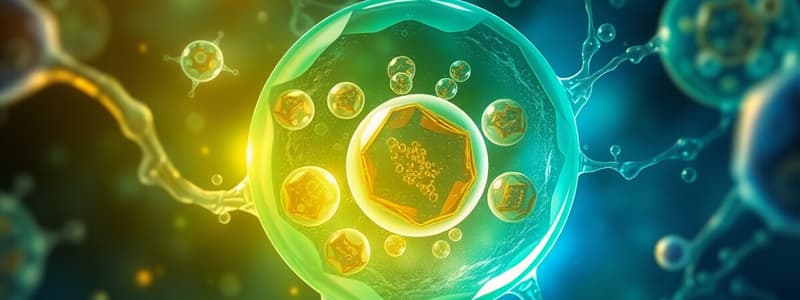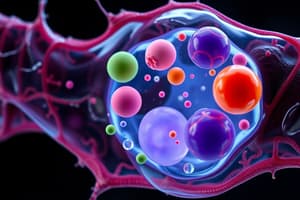Podcast
Questions and Answers
What is the primary function of mitochondria?
What is the primary function of mitochondria?
- DNA storage
- Cellular respiration (correct)
- Protein synthesis
- Cell division
Centrioles are involved in the process of cell division.
Centrioles are involved in the process of cell division.
True (A)
What are the three main components of the cytoskeleton?
What are the three main components of the cytoskeleton?
Microtubules, microfilaments, and intermediate filaments
The process of copying DNA into RNA is called ______.
The process of copying DNA into RNA is called ______.
Match the following cell organelles with their primary functions:
Match the following cell organelles with their primary functions:
Which of the following is NOT a stage of mitosis?
Which of the following is NOT a stage of mitosis?
Meiosis produces genetically identical daughter cells.
Meiosis produces genetically identical daughter cells.
What are the two main types of cell division?
What are the two main types of cell division?
Flashcards
Mitochondria
Mitochondria
Organelles responsible for aerobic metabolism and ATP production.
Nucleus
Nucleus
The cell organelle that houses DNA and is the site of RNA synthesis.
Ribosome
Ribosome
Cell structure that assembles proteins based on mRNA instructions.
Transcription
Transcription
Signup and view all the flashcards
Translation
Translation
Signup and view all the flashcards
Mitosis
Mitosis
Signup and view all the flashcards
Meiosis
Meiosis
Signup and view all the flashcards
Chromosomes
Chromosomes
Signup and view all the flashcards
Study Notes
Cell Organelles and Functions
- Cell organelles have diverse functions
- Mitochondria are involved in aerobic metabolism, producing ATP
- Nucleus contains DNA and is the site of RNA synthesis
- Centrioles aid in cell division
- Nucleolus is a ribosome synthesis site
- Endoplasmic reticulum (ER) synthesizes proteins and lipids
- Golgi apparatus processes and packages molecules
- Cytoskeleton has components (microtubules, microfilaments) that support and transport materials within the cell
- Motor proteins (kinesin, dynein) move materials along microtubules
Cytoskeleton
- Three major components: microtubules, microfilaments, and intermediate filaments
- Involved in cell structure and movement
- Microtubules provide pathways for motor proteins like kinesin and dynein
DNA and Protein Synthesis
- DNA is in chromatin form in the nucleus
- DNA condenses into chromatids, which prepare for cell division
- DNA is transcribed into RNA
- RNA serves as a template for protein synthesis (translation)
- Some DNA portions are non-coding (introns) and are removed, leaving coding sequences (exons)
Chromosomes
- Chromosomes are condensed structures containing DNA
- Humans have 23 pairs of chromosomes (46 total)
- Chromosomes exist in various states of condensation (chromatin, chromatids)
- Cell division processes require appropriate chromosome numbers
Cell Division (Mitosis and Meiosis)
- Mitosis produces identical daughter cells
- Meiosis produces unique daughter cells used in reproduction, with half the number of chromosomes
- Mistakes in cell division can result in chromosomal abnormalities like Down syndrome or other conditions
Protein Synthesis
- Protein synthesis needs amino acids, delivered by tRNA
- Ribosomes translate mRNA into proteins, following a genetic code
- The start codon is AUG (methionine)
- Codons are three-letter codes that specify amino acids
Studying That Suits You
Use AI to generate personalized quizzes and flashcards to suit your learning preferences.



